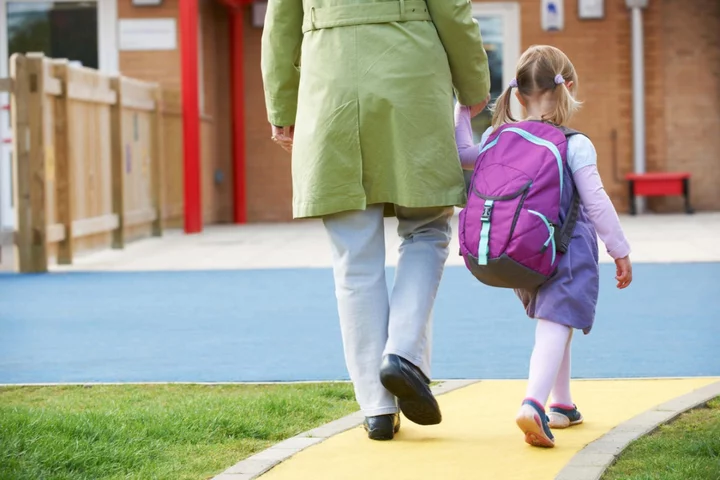
Gap Names Mattel’s Richard Dickson as New Chief Executive Officer
Gap Inc. named Mattel Inc. Chief Operating Officer Richard Dickson as its next chief executive officer, ending a
2023-07-26 21:26

Coca-Cola Raises Outlook as Consumers Head Back to Events
Coca-Cola Co. raised its full-year guidance after second-quarter results show continued momentum and consumer willingness to pay higher
2023-07-26 19:57

Grandmother with rare cancer that led to amputation shares first warning sign
A grandmother who was diagnosed with a rare cancerous tumour after her ankle “looked a bit swollen” had to have her leg amputated, but she is now walking with a prosthetic and has achieved her goal of waltzing again with her husband. Shirley Parnell, 75, a retired production coordinator, who lives in Kings Langley, Hertfordshire, with her husband, Lawrence, 76, a retired chartered surveyor, noticed a lump on her ankle in July 2022, and little did she know, it would lead to a devastating diagnosis. Shirley “assumed it would be something that (doctors) could fix”, but, after several scans, she was diagnosed with spindle cell sarcoma, a rare malignant cancerous tumour, and was told a leg amputation would be the only way forward. The mum of two and grandmother of two felt “shocked and in disbelief” as it “hadn’t even crossed (her) mind” that she was going to be diagnosed with cancer. After the surgery, Shirley had an “overwhelming sense of relief” and focused on getting better – to motivate herself, she set herself the goal of being able to dance with her husband again. But, while learning to walk again, Shirley was diagnosed with metastasis lung cancer and could not help but feel “a little bit cheated” as her parents lived until their 90s and she now knows “that’s probably not going to happen.” She did not let this get in the way of her achieving her goal, and in the middle June 2023, she danced with her husband again at a friend’s wedding and said she “had a real sense of achievement”. In July 2022, Shirley got her first warning sign of cancer when she experienced pain in her right ankle. Shirley told PA Real Life: “My ankle started to look a bit swollen – at first, I didn’t think anything of it as I assumed I had just knocked it on something in the house and not realised, but then I noticed a lump. “The lump kept moving around and the pain started to get more intense. So much so that I decided to go and see my local GP.” Shirley’s GP thought it could be a blood clot, so she was prescribed cream and tablets, but after a week, nothing improved. She was then referred to Watford General Hospital for a blood test and an X-ray. Shirley said: “I had just assumed it would be something that they could fix with some medication and the thought of something more serious didn’t really cross my mind. “It was only when they said that the X-ray had come back showing some abnormalities and they wanted me to have an MRI scan, a CT scan and a biopsy that I started to worry. “A few weeks went by, and I tried not to think about the results but then I got a call saying the results were back and they wanted to see me, and I just felt like it was going to be bad news.” At the appointment, Shirley was told she had spindle cell sarcoma, a rare malignant cancerous tumour which can develop in the bone or soft tissue. The doctor suggested that the only option for Shirley was to have her leg amputated to remove the tumour. She said: “As he said those words, I felt shocked and disbelief. “I thought at the time, only last week I was living my life normally, doing things I would come to take for granted such as walking to the shops or going to a Pilates class. “It hadn’t even crossed my mind that it might be cancer, let alone that I would lose a limb because of it.” So, on October 24 2022, at the Royal National Orthopaedic Hospital in Stanmore, Greater London, Shirley had the surgery. She said: “I was very nervous going into surgery but funnily enough I was okay once it was done. “I just had an overwhelming sense of relief that that part was finished. “Everyone has always said to me that I am a very determined person and after the surgery, I just started to look to the future as I felt everything was getting better, so I focused on working towards that.” But, once her leg was amputated, Shirley could not help but feel like she had lost some independence. She said: “Before I could just pop out to pick up some essentials but I had to rely on others to help me, something I am learning to get better at. “I’m so grateful for my husband running me around though.” On January 27 2023, Shirley had a cast made for her prosthetic leg, and it was fitted a week later. She said: “Then came the long and challenging journey of learning how to walk again. “The staff at the Prosthetic Rehabilitation Unit at the Royal National Orthopaedic Hospital were amazing and their support was what got me through those first few weeks and helped me get used to my new way of moving. “I felt strange but excited with my new leg – it felt like it was a real step forward into being more independent.” When in physiotherapy, Shirley made it her goal to be able to dance at her friend’s wedding with her husband. She said: “My husband and I always loved dancing – he joked that we’ll be doing a jive, but I said maybe a slow waltz.” But, at the end of April 2023, she was diagnosed with lung cancer. She said: “My parents lived until they were well into their 90s and I’ll be honest, I fully accepted with my family history that I would do the same. “So it came as a bit of a shock that I now know that that’s probably not going to happen. “I felt a little bit cheated, I suppose, but the other thing it has made me realise is that there are people a lot worse off than me.” Determined not to let the diagnosis impact her goal, Shirley practised walking even more, and at the middle June 2023, they danced together at the wedding. She said: “It was wonderful, I had a real sense of achievement, and being able to have a few dances during the evening was wonderful. “My husband was really proud of me too. “My family have been unbelievably supportive, I can’t thank them enough. “They were so happy for me that day.” Now, Shirley remains under the hospital’s care, having regular scans, and has since passed her driving assistance test. She is also raising money for the Royal National Orthopaedic Hospital Charity for its Impossible Possible campaign. Looking back on the last few years, she said: “I appreciate things a lot more now – I take time to appreciate my garden, the flowers blossoming, and my family. “I feel so lucky that I could have the amputation, and it puts things into perspective definitely.” Read More Mother reveals bruise on her toddler’s eye led to cancer diagnosis Jonnie Irwin details experience with palliative hospice care Ben Cohen’s ex-wife says she had only ‘one symptom’ before cancer diagnosis What is cardiac arrest? The condition that LeBron James’ son suffered from Mom left ‘appalled’ after water park says she can’t breastfeed son in lazy river Government has more work to do to ensure families secure quality childcare – MPs
2023-07-26 19:50

US Consumer Weakness Erodes Sales at LVMH, Unilever and More
European consumer-goods companies from LVMH to Unilever Plc and British American Tobacco Plc highlighted recent softness in US
2023-07-26 19:50

Woman rescued from mountain after trying to find scared pet parrot
Mountain rescuers came to the aid of a woman and her pet parrot in the United Kingdom this week after she became stranded trying to find one of her feathered friends, who was scared off by a peregrine falcon.
2023-07-26 19:26

'Hero' dad takes daughter to see Barbie dressed in pink leotard and tutu
A dedicated dad has gone viral for dressing up in a pink leotard and tutu to take his young daughter to see ‘Barbie’ at the cinema. Eleazar Rodríguez Hernández took his daughter to see the hit film starring Margot Robbie on its opening weekend. He explained: “My daughter said ‘Daddy take me to the premiere of Barbie, but wear something pink or are you too embarrassed?’” He added: “I think the one who's going to be embarrassed is her!” In the images, Rodríguez is seen sporting a pink leotard and white tutu along with a broad grin. Sign up to our free Indy100 weekly newsletter He completes the outfit with a cowboy hat and boots. Rodríguez took his daughter to see Barbie at the Cinépolis cinema in Nuevo Laredo, Tamaulipas, México, on 21 July. In one photo, the proud dad is seen buying entry tickets at the counter in his special outfit. He accompanied the image with the mock conversation: “What movie do you want to see? “The Super Mario Bros Movie, idiot!” Rodríguez said: “I made these posts without wanting to highlight myself, I just did what my daughter wanted. “I would do anything for her. “She was so happy. “Believe me, wearing pink clothes and a tutu does not make you any less of a man.” Photos of Rodríguez and his daughter have gone viral on Facebook with thousands of shares and comments. One local said: “These are the moments your daughter will remember most! I know because I carry in my heart everything my dad did in my childhood to make me happy.” Andy commented: “You are a f***ing crack... A f***ing hero without a cape... You are the boss of bosses!” Licia wrote: “That's a great father who does everything for his daughter. Blessings.” Enit remarked: “What a beautiful memory for his daughter. She will treasure that so much in the future. He's a dad worth millions.” Jesús said: “I want to be like you when I grow up.” Have your say in our news democracy. Click the upvote icon at the top of the page to help raise this article through the indy100 rankings.
2023-07-26 16:59

Government has more work to do to ensure families secure quality childcare – MPs
The Government has more work to do to address “structural problems” in the early years system to ensure families benefit from high-quality affordable childcare under its reforms, MPs have said. Plans to expand the number of subsidised childcare places for working parents in England “should not come at the expense of quality”, the Commons Education Select Committee has warned. From September, the Government will change minimum staff-to-child ratios from 1:4 to 1:5 for two-year-olds in England, but it will remain optional. The group of MPs said it is “deeply concerned” about the plans and it is calling on the Government to reverse the changes “if quality is degraded”. Chancellor Jeremy Hunt announced reforms in the Budget in March which will allow some families of children as young as nine months in England to claim 30 hours of free childcare a week. Simply extending the number of hours that the Government calls free will not work unless the funding rates accurately reflect the costs of providing high quality early education and childcare Committee chairman Robin Walker From April next year, working parents of two-year-olds will be able to access 15 hours of free childcare. This will be extended to working parents of all children older than nine months from September next year. From September 2025, working parents of children under five will be entitled to 30 hours of free childcare per week. The Education Select Committee said it was a “welcome investment” following concerns raised by parents and early years providers during its inquiry about “affordability and sustainability”. The report added: “However, this investment is much overdue and more will need to be done to address the structural problems in the ECEC (Early Childhood Education Care) system if the funding increases are to be implemented effectively. “In particular, close attention should be paid to effective funding distribution. Settings in disadvantaged areas already struggle more than those in more affluent areas, yet we know that it is children from disadvantaged families that can benefit the most from high-quality ECEC.” The Treasury “missed an opportunity” to reform tax-free childcare and increase the flexibility of the system under its plans to expand free childcare for working parents, the report said. Under the current system, working parents of three and four-year-olds in England are eligible for 30 hours of free childcare per week. The tax-free childcare scheme also allows eligible working families to claim 20% government support with their childcare costs, up to an annual limit of £2,000 per child. The Commons Education Select Committee report said the requirement for parents to reconfirm their eligibility every three months for the 30 hours entitlement and tax-free childcare scheme is “unduly onerous” and should be reduced to once per year. Committee chairman Robin Walker said: “The childcare market is facing significant challenges in affordability and availability, with unprecedented staff turnover and nurseries closing, despite massive demand from parents who want a career and to provide for their families but struggle to find affordable services. It is clear that ministers have more work to do to address this. “Simply extending the number of hours that the Government calls free will not work unless the funding rates accurately reflect the costs of providing high-quality early education and childcare. “We have heard that many settings rely on charging more for the children who attend them outside of the funded hours. It is therefore essential that ministers reduce burdens on the sector and provide adequate funding for all the stages of early education.” He added: “Staff are the lifeblood of this sector and the huge expansion of subsidised childcare will only be successful if we can stem the tide of people leaving the workforce. “There needs to be a revamp of career development, with improvements to pay, progression and conditions so that the profession is given the respect and status it deserves.” Not only have years of severe underfunding plagued the sector but the worst staffing crisis in decades has created a perfect storm which must be addressed if the sector has any chance of survival in the coming years Neil Leitch, Early Years Alliance The cross-party group of MPs is calling on the Department for Education (DfE) to “work closely” with childcare providers and local authorities across the country “to set the funding rate at a sufficient level.” It added that the DfE should stop describing the 30 hours offer as ‘free hours’ and instead refer to it as ‘funded’ or ‘subsidised’ hours to “improve parental trust” in the childcare subsidy system. Neil Leitch, chief executive of the Early Years Alliance (EYA), said: “Not only have years of severe underfunding plagued the sector but the worst staffing crisis in decades has created a perfect storm which must be addressed if the sector has any chance of survival in the coming years. “If that wasn’t bad enough, it’s likely that the upcoming sector expansion will be dangerously underfunded and will place unrealistic expectations on providers already on the brink.” He added: “For the committee’s findings to truly have a lasting impact, we hope against hope that it finally wakes the Government up to the reality of the situation facing families and providers and prompts urgent and effective action.” Last week, the Government said reforms expanding the amount of free childcare for parents will be “properly and fairly funded”. The DfE said its proposed new funding formula, which is now out for consultation, provides “additional funding for areas of deprivation”. The increased funding will see the expected average rate paid to local authorities for 2024/25 to be set at £8.17 for two-year-olds and £11.06 for under-twos, the DfE said. A Government spokesperson said: “We are rolling out the single biggest investment in childcare in England ever, set to save a working parent using 30 hours of childcare up to an average of £6,500 per year and give children the best quality early years education. “To make sure that we are supporting our fantastic early years workforce, we will be investing hundreds of millions of pounds each year to increase the amounts we pay childcare providers. We also are consulting on how we distribute funding to make sure it is fair.” Read More Charity boss speaks out over ‘traumatic’ encounter with royal aide Ukraine war’s heaviest fight rages in east - follow live Wall squat exercises can help lower blood pressure, study suggests Wall sits and planks the best exercises for lowering blood pressure, study suggests Everything you need to know about using a defibrillator
2023-07-26 16:30

Wall squat exercises can help lower blood pressure, study suggests
Exercises such as “wall sits” could be the best form of activity to help people reduce blood pressure, a new study suggests. Other physical activity including cardio, resistance training and HIIT workouts are also good for bringing down resting blood pressure levels, researchers found. But isometric exercises – those that involve engaging muscles without movement, such as wall sits and planks – provide the best results, they said. The study, published in the British Journal of Sports Medicine, saw researchers conduct analysis on previous studies looking at exercise and blood pressure. These findings provide a comprehensive data driven framework to support the development of new exercise guideline recommendations for the prevention and treatment of arterial hypertension Researchers Some 270 studies were included in the final analysis which contained data on almost 16,000 people. They examined the impact different exercises had on systolic blood pressure, which notes the force at which the heart pumps blood around the body; and diastolic blood pressure, the resistance to the blood flow in the blood vessels between heartbeats when blood is pumped around the heart. The researchers, led by academics at Canterbury Christ Church University in Kent, found that there were significant reductions in resting blood pressure following cardio (aerobic exercise); dynamic resistance training, such as squats, press-ups and weights; high intensity interval training (HIIT); and combined training and HIIT. But the largest reductions were seen after isometric exercise training. A secondary analysis on specific types of exercises found the most benefit was seen among those who performed “isometric wall squats” and among runners. The academics said that current exercise recommendations for the prevention and treatment of high blood pressure are based on “older data” and suggest that it may be time to review the current guidelines. “Aerobic exercise training, dynamic resistance training, combined training, high-intensity interval training and isometric exercise training are all significantly effective in reducing resting systolic and diastolic blood pressure,” they wrote. “Overall, isometric exercise training is the most effective mode in reducing both systolic and diastolic blood pressure. “These findings provide a comprehensive data driven framework to support the development of new exercise guideline recommendations for the prevention and treatment of arterial hypertension.” For the average adult high blood pressure is considered to be from 140/90mmHg. When a person’s blood pressure is too high it puts extra strain on blood vessels, heart and other organs, such as the brain, kidneys and eyes. Persistent high blood pressure can lead to a number of serious health problems including heart attacks, strokes and vascular dementia. While there are medications which can help, people can make a number of life-style changes to help bring their blood pressure down including regular exercise, losing weight, cutting back on caffeine, alcohol and salt. Read More Charity boss speaks out over ‘traumatic’ encounter with royal aide Ukraine war’s heaviest fight rages in east - follow live Wall sits and planks the best exercises for lowering blood pressure, study suggests Everything you need to know about using a defibrillator What you need to know about the massive LVMH deal with the Paris Olympics
2023-07-26 16:25

Husband fired from family business after wife roleplayed with reborn dolls
A woman who turned to roleplaying with hyper-realistic dolls “to help (her) cope” with the death of her first baby – and continues to do so with her husband and two rainbow babies – has said her husband’s parents disapproved of the hobby and fired him from the family business as a result. Christina Keeler, 38, a stay-at-home mum and YouTuber, from Wyalusing, Pennsylvania, USA, fell pregnant with her first “miracle” baby in 2015, despite having endometriosis and being told she would not be able to conceive in her 20s. She suffered a miscarriage, but after watching a documentary about so-called reborn dolls, she had a “lightbulb moment” and realised getting a hyper-realistic doll would be the “perfect solution”. Christina’s husband Bill, 43, was “hesitant” at first but became supportive after he saw how much it “helped (her) grief”. The couple went on to have two “miracle” daughters, Grace, six, and Joy, four, who now help feed, change and dress the family’s five reborn dolls – which cost between £1,560 and £3,899 each – in their “nursery” complete with “a crib and a wardrobe”. The family often take the dolls out in public, and have shared their journey on YouTube – where Christina documents people’s reactions to her dolls and birthing videos. Some silicone dolls come in a fake womb which allows a Caesarean section to be performed at home. But Bill’s family were “disgusted” with the hobby, to the point where they gave him a choice to stop having the dolls or leave the family business. He refused to shut down the YouTube channel and did not want Christina to give up her hobby, so he was fired. She fell pregnant with her first baby in 2015, a year after her mother died of cancer. The couple were “elated” about the pregnancy because Christina had been told in her twenties that she would not be able to conceive because she has endometriosis, but she miscarried at eight weeks. Christina told PA Real Life: “When we lost the baby it was so devastating, I remember lying in the hospital bed after they had taken the baby out of my belly, and screaming for my mum and wept wanting to cuddle my baby.” She “really struggled” with the grief of losing her mother and her baby so close together. She explained: “This feeling of sorrow just never went away, it was so painful that I never talked about it again.” Despite having her two “miracle” children Grace and Joy, Christina still longed to hold her first baby, and after watching a documentary about reborn dolls, she wanted to get one to see if it would help her grief. She said: “I felt so blessed to have two healthy girls, but that feeling of missing the first baby never quite went away. “When my youngest was around two years old, my husband and I came across a documentary about reborn dolls. “And he was like, ‘That’s really weird’, and I played it off that I thought the same, but actually I really wanted one to help me cope and I thought it would be the perfect solution.” After persuading her husband, Christina ordered her first lifelike doll, Hannah, costing her around £155. She said: “I told my husband and he was not on board at all, he was hesitant, but after explaining my reasoning, he was much more understanding and more accepting.” When the doll arrived, Christina instantly felt like it helped with her mourning. She said: “It helped me therapeutically because for the first time ever when I got my first reborn doll, I was able to talk about the loss of our baby. “And since then I have healed tremendously from that loss because I’m able to talk about it and share my story and help others – it helped my grief, for sure.” Christina now has a collection of five dolls called Carter, Cadence, Quinn, Isabella and Sammy, which she loves to dress, cuddle and feed. She takes the dolls out in public and people often mistake them for real babies. She said: “We have a nursery for them with a crib and a wardrobe. I check on them throughout the day, and on other days, especially when the girls want to get involved, I pick out an outfit for them, bring them to breakfast, get them to feed them a bottle, change them. “If we’re running errands we often take them out with us and put them in a car seat and stroller.” Christina and her family have been sharing their experiences on YouTube, where they are known as The Reborn Family. She said: “I make videos about people’s reactions to my dolls, as well as vlogs and birthing videos – I have some silicone reborn dolls which come in a womb and you perform a C-section on it at home, to give birth to the baby.” Despite her immediate family being supportive of the hobby, Christina admits not everyone in her wider family understands. She said: “My husband’s family were, and still are, disapproving of the reborns, even though they can see how much they helped me. They were disgusted. “We moved from California to Pennsylvania because my husband was next in line to take over the family business because they were about to retire, and they asked if we would like to do so and we agreed. “When they were on vacation they came across our YouTube channel, and they called us up and they were mortified and so embarrassed, and said we were ruining the family name.” When Bill’s parents came home, they gave him an ultimatum to stop having the dolls. Christina explained: “Bill said that he was not going to quit his job, and didn’t want me to stop having reborns because they were so therapeutic for me at the time, and his dad said, ‘Well, then you’re fired’.” My husband’s family were disgusted, they said we were ruining the family name Bill’s father was contacted by PA Real Life for comment, but he had not responded at the time of publication. Even though her reborns have caused tension in the family, Christina cannot see herself giving up her hobby any time soon. She said: “Reborns continue to help me with my grief, and I love sharing content with other people who have lost babies, and they can also really help people with dementia, people who are infertile, people with anxiety and depression, I wouldn’t want to stop this.” Read More Teenager who thought she was pregnant diagnosed with ovarian cancer Woman praised for response to parents who asked her to swap first class seat with their child Barbie vs Oppenheimer: Greta Gerwig makes history with biggest box office opening for a female director
2023-07-26 13:57

New Zealand, Australia to Explore Options for Seamless Travel
New Zealand and Australia are to explore moves toward more “seamless travel” between the two nations to enhance
2023-07-26 13:25

Ozempic users report stomach paralysis as weight loss drug side effect: ‘I wish I never touched it’
A recent investigation has found that some Ozempic and Wegovy patients suffered from severe gastroparesis, also known as stomach paralysis, after taking the medications. In a report from CNN published on 25 July, two patients reported that their “stomachs are paralysed” after taking type 2 diabetes drug Ozempic – a semaglutide injection known for its weight loss side effects. “I wish I never touched it. I wish I’d never heard of it in my life,” Joanie Knight, a 37-year-old from Louisiana, told CNN. “This medicine made my life hell. So much hell. It has cost me money. It cost me a lot of stress; it cost me days and nights and trips with my family. It’s cost me a lot, and it’s not worth it. The price is too high.” Emily Wright, a 38-year-old teacher from Toronto, said she vomits so frequently that she had to take a leave of absence from her job. “I’ve almost been off Ozempic for a year, but I’m still not back to my normal,” she said. According to CNN, both women have been diagnosed with severe gastroparesis, a disorder that slows or stops the movement of food from the stomach to the small intestine, per the Mayo Clinic. Wright has also been diagnosed with cyclic vomiting syndrome, which causes her to throw up multiple times a day. Meanwhile, one Wegovy user claimed she began experiencing stomach problems after her doctor prescribed her the weight loss drug – which works by mimicking a hormone called glucagon-like peptide 1 (GLP-1), regulating blood sugar levels and slowing down the rate at which food leaves the stomach to create the feeling of fullness. However, the medication caused her to vomit so much that she became dehydrated and needed to visit urgent care. Brenda Allen, from Texas, has since been managing her nausea and vomiting with a medication called Zofran and prescription probiotics. Now, the US Food and Drug Administration has said they’ve received reports of stomach paralysis among patients taking the medications. “The FDA has received reports of gastroparesis with semaglutide and liraglutide, some of which documented the adverse event as not recovered after discontinuation of the respective product at the time of the report,” the agency said in a statement to CNN. However, officials clarified that they were unable to determine whether taking Ozempic or Wegovy was the cause of stomach paralysis, or if it was caused by a different issue. “Gastroparesis can be a complication of diabetes that is related to long-standing or poorly controlled disease, further complicating the ability to determine what role the drugs played in the reported events,” they said. As for whether patients should be warned about taking the drugs, the FDA maintained that taking the medications, such as for treating diabetes or weight management, may still “outweigh the risks in some patients with gastroparesis or delayed gastric emptying”. In response to reports of stomach paralysis, Novo Nordisk – the manufacturer behind Ozempic and Wegovy – noted that these drugs have been extensively studied in the real world and in clinical trials. “Gastrointestinal (GI) events are well-known side effects of the GLP-1 class,” the company told CNN. “For semaglutide, the majority of GI side effects are mild to moderate in severity and of short duration. GLP-1’s are known to cause a delay in gastric emptying, as noted in the label of each of our GLP-1 RA medications. Symptoms of delayed gastric emptying, nausea and vomiting are listed as side effects.” Last week, the American Society of Anesthesiologists also issued a warning that those who take GLP-1 agonists should avoid the medications a week before surgery because they may increase “risk of regurgitation and aspiration of food” while under anesthesia and deep sedation. Ozempic, a once-weekly injection used for the treatment of type 2 diabetes, has skyrocketed in use after people were reportedly prescribed the FDA-approved diabetes medication as an “off-label” weight loss drug. However, because of its increasing popularity, it has led to national shortages of the diabetes treatment - leaving those who actually need Ozempic without it. Meanwhile, Wegovy and Mounjaro are popular once-weekly semaglutide injections specifically approved for the treatment of obesity and weight loss. There are many side effects of taking medications like Ozempic, Wegovy, and Mounjaro. According to the FDA, the most common side effects of taking Wegovy are nausea, diarrhea, vomiting, constipation, abdominal pain, headache, fatigue, indigestion, dizziness, and digestive disorders. The FDA has also warned about more serious complications that can occur from use of Wegovy or Mounjaro, such as the “potential risk of thyroid C-cell tumours,” pancreatitis, gallbladder problems, acute kidney injury, increased heart rate, and suicidal behaviour or thinking. Taking Ozempic can also lead to possible thyroid tumours, including cancer, pancreatitis, changes in vision, and kidney and gallbladder problems. The Independent has contacted Novo Nordisk and the FDA for comment. Read More Clinics told to stop prescribing medicines as weight loss drug hits diabetes supply Influencer addresses ‘dangers’ of complimenting people’s bodies after weight loss comments Ozempic under EU investigation over reports of suicidal thoughts Mindy Kaling shuts down weight loss question as ‘people take it so personally’ What are weight loss injections and what’s the controversy? Raven Symone says people shouldn’t use Ozempic for ‘glamazon purposes’
2023-07-26 06:19

Mother asks if children should be ‘forced to share’ after son is ‘pushed’ for not sharing on splash pad
A mother has questioned whether children should be “forced” to share after revealing an incident in which her son was allegedly “pushed” by another child on a splash pad for not sharing. Skye Amundsen, a mother from Maryland who goes by the username @hopeandplum on TikTok, reflected on the incident in a video posted earlier this month. According to Amundsen, who noted that the video was a “message to the mom that had the audacity to tell me that my son should have to share at the splash pad,” she and her two-year-old son had been playing at a local park with an outdoor sprinkler when the confrontation occurred. “Now, hear me out before you judge me. My son is two. He’s playing. He likes to step on the little things on the splash pad and stop them from splashing up,” the TikToker said. “This splash pad has tons of these, so he’s not hurting anyone.” In the video, the TikToker said that a little girl, who was “unhappy” with her son’s behaviour, then walked up to the two year old and “pushes him”. “She’s bigger than him and she pushes him. And my son’s like: ‘No’ and he steps back on it,” Amundsen recalled. “And she pushes him again.” According to Amundsen, she was “sitting there watching” and “waiting” for the mother of the other child to intervene. “I was like, well, you know, I’m going to give her a chance,” the TikToker said. @hopeandplum What do you think? We don’t force sharing and find our kids do it naturally most of the time. But why would anyone share with someone being mean? #newmomtips #summermom #momlife ♬ original sound - hope&plum | Baby Carriers Amundsen said that the other mother didn’t intervene despite the woman’s daughter allegedly pushing her two year old for a third time. However, after the third time, the TikToker said her son got “mad” and pushed the other child back. “So I intervene, because I’m his mother and I’m not going to let him push people,” Amundsen continued, adding that, as she was talking to her son, the other mother approached her to confront her about her son’s behaviour. “As I’m talking to my son, this woman has the audacity to say to me: ‘You should really teach your son to learn how to share, it would be better for him,’” the TikToker said. “I’m sorry, my son should learn how to share? Your daughter walked up and shoved my son three times, so my child should allow your child to push him and that’s acceptable and he should share with that human?” In the video, Amundsen then acknowledged that “everyone has different opinions on sharing,” and that she “likes” sharing and “thinks it’s nice,” but also doesn’t believe “you have to force your child to share, especially when another child is getting physical with them”. According to Amundsen, she ultimately told the other mother that they could “agree to disagree” when it came to their respective opinions about sharing. As of 25 July, the TikToker’s video, which she captioned: “What do you think? We don’t force sharing and find our kids do it naturally most of the time. But why would anyone share with someone being mean?” has been viewed more than 609,000 times, prompting other parents to weigh in in the comments. In response, the majority of viewers said they agreed with Amundsen on the basis that sharing shouldn’t be expected after “pushing”. “I totally agree with you. Definitely not sharing after pushing. Oh heck no,” one person wrote. Another said: “Absolutely agree. Also what is he supposed to share? I don’t understand, she wants him to let her use the single water spout that he was playing with?” “Wowww, the nerve of that other mom. In all fairness, you have better control than me,” someone else wrote, prompting Amundsen to reveal that she was “too stunned to speak” during the confrontation. In response to another comment, she said she was in “true shock” but that she was later “kicking” herself for “not saying more”. The Independent has contacted Amundsen for comment. Read More Woman claims restaurant ‘hack’ for toddlers solves family dinners out Woman praised for refusing to switch first class seat on plane with child Mom sparks backlash for piercing newborn’s ears in hospital: ‘How is that even legal?’ Schoolboy almost dies from swallowing magnets for TikTok challenge Woman shares honest review of New York City apartment TikTok mom slammed after making 5-year-old son run in 104 degree heat
2023-07-26 05:57
